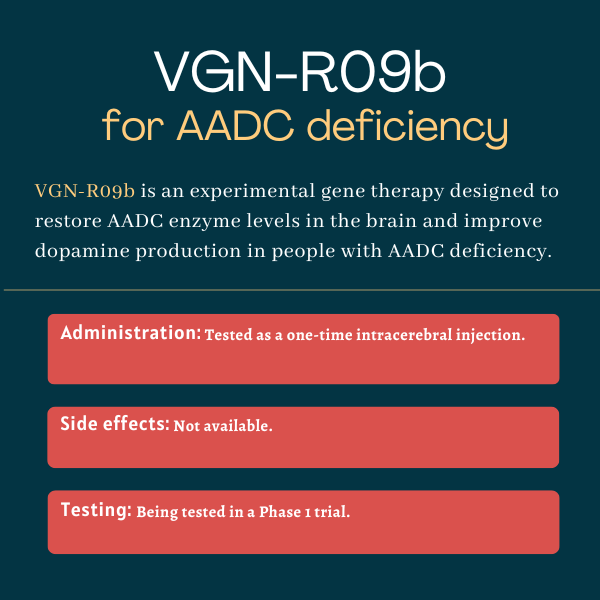VGN-R09b for AADC deficiency
Last updated Aug. 1, 2025, by Andrea Lobo, PhD

What is VGN-R09b for AADC deficiency?
VGN-R09 is an experimental gene therapy being developed by Shanghai Vitalgen BioPharma to restore AADC enzyme levels in the brain and improve motor function in people with aromatic l-amino acid decarboxylase (AADC) deficiency.
AADC deficiency is caused by mutations in both copies of the DDC gene, which carries instructions to produce the AADC enzyme. The enzyme is involved in producing several key neurotransmitters, the chemical messengers used by nerve cells to communicate.
The condition leads to symptoms such as motor and developmental delays, autonomic dysfunction (problems with involuntary bodily functions), and abnormal movements.
VGN-R09b is a gene therapy that uses an adeno-associated virus (AAV), a harmless viral vector that specifically targets nerve cells, to deliver therapeutic genetic material directly to the brain. It carries two genes — a working copy of the DDC gene, which encodes the AADC enzyme, and a second gene that encodes a neurotrophic factor that supports nerve cell health.
By restoring the levels of a functional AADC enzyme, VGN-R09b should boost the production of dopamine, a neurotransmitter involved in movement, and improve motor function in people with AADC deficiency. The second gene increases the production of glial cell line-derived neurotrophic factor (GDNF), which further enhances dopamine production.
The therapy is also being developed for other neurodegenerative disorders.
Therapy snapshot
| Treatment name: | VGN-R09b |
| Administration: | Intracerebral injection |
| Clinical testing: | Currently being tested in a Phase 1 trial |
How will VGN-R09b be administered?
In a Phase 1 clinical trial evaluating VGN-R09b in individuals with AADC deficiency, the gene therapy is being administered as a one-time intracerebral injection into the striatum, a brain region critical for motor control. Two dose levels are being tested: 6.0 × 10¹¹ and 1.28 × 10¹² viral genomes (vg).

VGN-R09b in clinical trials
VGN-R09b was investigated in an early, investigator-sponsored Phase 1 trial (NCT05765981) that enrolled six children with AADC deficiency, ages 2 to 8. The children received a single dose of the treatment delivered directly to both sides of the striatum.
The delivery procedure was safe and the children recovered well from the surgery, results showed. Within four weeks of treatment, increases in AADC enzyme activity were observed, followed by a gradual easing of symptoms and recovery of motor function. Some children reached key motor milestones, such as lifting their heads and sitting independently, according to the company.
The treatment is also being evaluated in a Phase 1 trial (NCT06432140), which seeks to enroll 16 children with AADC deficiency, ages 2 to 8. The study is testing two escalating doses, with the primary goals being to assess safety and track how many participants achieve key developmental milestones, such as head control, sitting independently, standing or stepping with support, and walking with minimal assistance.
The effect on brain AADC activity, neurotransmitter levels, motor function, and disease-related symptoms will also be evaluated.
Early results showed the procedure was safe for the first child treated. AADC enzyme activity increased noticeably at the injection site and markers of dopamine production in the brain also began to improve. The child showed significant progress in movement and hand-grasping abilities compared with before treatment.
VGN-R09b side effects
No side effects have been reported so far in children treated with VGN-R09b.
AADC News is strictly a news and information website about the disease. It does not provide medical advice, diagnosis, or treatment. This content is not intended to be a substitute for professional medical advice, diagnosis, or treatment. Always seek the advice of your physician or other qualified health provider with any questions you may have regarding a medical condition. Never disregard professional medical advice or delay in seeking it because of something you have read on this website.
Recent Posts
- AI model popEVE predicts likelihood of harm from ultra-rare DNA mutations
- Our holiday trip is a symbol of our daughter’s journey after gene therapy
- NORD adds 7 sites in 5 states as Rare Disease Centers of Excellence
- Simple strategies and new exercises help to correct mouth breathing
- New AI tool for doctors’ notes may save patients years to be diagnosed